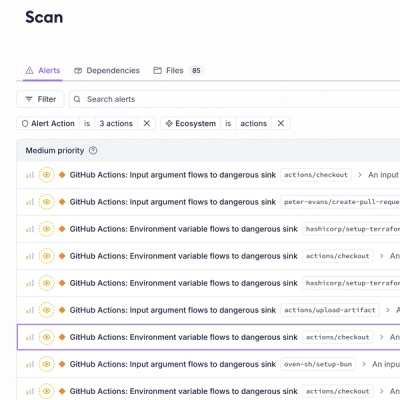
Product
Introducing Socket Firewall Enterprise: Flexible, Configurable Protection for Modern Package Ecosystems
Socket Firewall Enterprise is now available with flexible deployment, configurable policies, and expanded language support.
A simple and hackable CLI tool for converting markdown to pdf. It uses Marked to convert markdown to html and Puppeteer (headless Chromium) to further convert the html to pdf. It also uses highlight.js for code highlighting. The whole source code of this tool is only ~250 lines of JS ~500 lines of Typescript and ~100 lines of CSS, so it is easy to clone and customize.
Highlights:
stdioOption 1: NPM
npm i -g md-to-pdf
Option 2: Git
If you want to have your own copy to hack around with, clone the repository instead:
git clone "https://github.com/simonhaenisch/md-to-pdf"
cd md-to-pdf
npm link # or npm i -g
Then the commands md-to-pdf and md2pdf (as a shorthand) will be globally available in your cli. Use npm start to start the TypeScript compiler (tsc) in watch mode.
If you installed via npm, run npm i -g md-to-pdf@latest in your CLI. If you cloned this repository instead, you can simply do a git pull to get the latest changes from the master branch, then do npm run build to re-build. Unless there have been changes to packages (i. e. package-lock.json), you don't need to re-install the package (because NPM 5+ uses symlinks, at least on Unix systems).
$ md-to-pdf [options] path/to/file.md
Options:
-h, --help ............... Output usage information
-v, --version ............ Output version
-w, --watch .............. Watch the current file(s) for changes
--watch-options .......... Options for Chokidar's watch call
--basedir ................ Base directory to be served by the file server
--stylesheet ............. Path to a local or remote stylesheet (can be passed multiple times)
--css .................... String of styles
--document-title ......... Name of the HTML Document.
--body-class ............. Classes to be added to the body tag (can be passed multiple times)
--page-media-type ........ Media type to emulate the page with (default: screen)
--highlight-style ........ Style to be used by highlight.js (default: github)
--marked-options ......... Set custom options for marked (as a JSON string)
--pdf-options ............ Set custom options for the generated PDF (as a JSON string)
--launch-options ......... Set custom launch options for Puppeteer
--gray-matter-options .... Set custom options for gray-matter
--port ................... Set the port to run the http server on
--md-file-encoding ....... Set the file encoding for the markdown file
--stylesheet-encoding .... Set the file encoding for the stylesheet
--as-html ................ Output as HTML instead
--config-file ............ Path to a JSON or JS configuration file
--devtools ............... Open the browser with devtools instead of creating PDF
The pdf is generated into the same directory as the source file and uses the same filename (with .pdf extension) by default. Multiple files can be specified by using shell globbing, e. g.:
md-to-pdf ./**/*.md
(If you use bash, you might need to enable the globstar shell option to make recursive globbing work.)
Alternatively, you can pipe the markdown in from stdin and redirect its stdout into a target file:
cat file.md | md-to-pdf > path/to/output.pdf
Tip: You can concatenate multiple files using cat file1.md file2.md.
The current working directory (process.cwd()) serves as the base directory of the file server by default. This can be adjusted with the --basedir flag (or equivalent config option). Note that because of the file server, if you convert a file that's outside the current folder, you'll have to move the base directory up as well (e. g. md-to-pdf ../path/to/file.md --basedir ..).
Watch mode (--watch) uses Chokidar's watch method on the markdown file. If you're having issues, you can adjust the watch options via the config (watch_options) or --watch-options CLI arg. The awaitWriteFinish option might be particularly useful if you use editor plugins (e. g. TOC generators) that modify and save the file after the initial save. Check out the Chokidar docs for a full list of options.
Note that Preview on macOS does not automatically reload the preview when the file has changed (or at least not reliably). There are PDF viewers available that can check for file changes and offer auto-reload (e. g. Skim's "Sync" feature).
The programmatic API is very simple: it only exposes one function that accepts either a path to or content of a markdown file, and an optional config object (which can be used to specify the output file destination).
const fs = require('fs');
const { mdToPdf } = require('md-to-pdf');
(async () => {
const pdf = await mdToPdf({ path: 'readme.md' }).catch(console.error);
if (pdf) {
fs.writeFileSync(pdf.filename, pdf.content);
}
})();
The function throws an error if anything goes wrong, which can be handled by catching the rejected promise. If you set the dest option in the config, the file will be written to the specified location straight away:
await mdToPdf({ content: '# Hello, World' }, { dest: 'path/to/output.pdf' });
Place an element with class page-break to force a page break at a certain point of the document (uses the CSS rule page-break-after: always), e. g.:
<div class="page-break"></div>
Use headerTemplate and footerTemplate of Puppeteer's page.pdf() options. If either of the two is set, then displayHeaderFooter will be enabled by default. It's possible to inject a few dynamic values like page numbers by using certain class names, as stated in the Puppeteer docs. Please note that for some reason the font-size defaults to 1pt, and you need to make sure to have enough page margin, otherwise your header/footer might be overlayed by your content. If you add a <style/> tag in either of the templates, it will be applied to both header and footer.
Example markdown frontmatter config that prints the date in the header and the page number in the footer:
---
pdf_options:
format: a4
margin: 30mm 20mm
printBackground: true
headerTemplate: |-
<style>
section {
margin: 0 auto;
font-family: system-ui;
font-size: 11px;
}
</style>
<section>
<span class="title"></span>
<span class="date"></span>
</section>
footerTemplate: |-
<section>
<div>
Page <span class="pageNumber"></span>
of <span class="totalPages"></span>
</div>
</section>
---
Refer to the Puppeteer docs for more info about header and footer templates.
This can be achieved with MathJax. A simple example can be found in /src/test/mathjax.
For default and advanced options see the following links. The default highlight.js styling for code blocks is github. The default PDF options are the A4 format and some margin (see lib/config.ts for the full default config).
| Option | Examples |
|---|---|
--basedir | path/to/folder |
--stylesheet | path/to/style.css, https://example.org/stylesheet.css |
--css | body { color: tomato; } |
--document-title | Read me |
--body-class | markdown-body |
--page-media-type | print |
--highlight-style | monokai, solarized-light |
--marked-options | '{ "gfm": false }' |
--pdf-options | '{ "format": "Letter", "margin": "20mm", "printBackground": true }' |
--launch-options | '{ "args": ["--no-sandbox"] }' |
--gray-matter-options | null |
--port | 3000 |
--md-file-encoding | utf-8, windows1252 |
--stylesheet-encoding | utf-8, windows1252 |
--config-file | path/to/config.json |
margin: instead of an object (as stated in the Puppeteer docs), it is also possible to pass a CSS-like string, e. g. 1em (all), 1in 2in (top/bottom right/left), 10mm 20mm 30mm (top right/left bottom) or 1px 2px 3px 4px (top right bottom left).
highlight-style: if you set a highlight style with a background color, make sure that "printBackground": true is set in the pdf options.
The options can also be set with front-matter or a config file (except --md-file-encoding can't be set by front-matter). In that case, remove the leading two hyphens (--) from the cli argument name and replace the hyphens (-) with underscores (_). --stylesheet and --body-class can be passed multiple times (i. e. to create an array). It's possible to set the output path for the PDF as dest in the config. If the same config option exists in multiple places, the priority (from low to high) is: defaults, config file, front-matter, cli arguments.
The JS engine for front-matter is disabled by default for security reasons. You can enable it by overwriting the default gray-matter options (--gray-matter-options null, or gray_matter_options: undefined in the API).
Example front-matter:
---
dest: ./path/to/output.pdf
stylesheet:
- path/to/style.css
body_class: markdown-body
highlight_style: monokai
pdf_options:
format: A5
margin: 10mm
printBackground: true
---
# Content
The config file can be a Javascript file that exports a config object, which gives you the full power of the eco-system (e. g. for advanced header/footer templates); or it can also be a .json if you like it simple.
Example config.js:
module.exports = {
stylesheet: ['path/to/style.css', 'https://example.org/stylesheet.css'],
css: `body { color: tomato; }`,
body_class: 'markdown-body',
marked_options: {
headerIds: false,
smartypants: true,
},
pdf_options: {
format: 'A5',
margin: '20mm',
printBackground: true,
},
stylesheet_encoding: 'utf-8',
};
Example config.json:
{
"highlight_style": "monokai",
"body_class": ["dark", "content"]
}
Here is an example front-matter for how to get Github-like output:
---
stylesheet: https://cdnjs.cloudflare.com/ajax/libs/github-markdown-css/2.10.0/github-markdown.min.css
body_class: markdown-body
css: |-
.page-break { page-break-after: always; }
.markdown-body { font-size: 11px; }
.markdown-body pre > code { white-space: pre-wrap; }
---
By default, this tool serves the current working directory via a http server on localhost on a relatively random port (or the port you specify), and that server gets shut down when the process exits (or as soon as it is killed). Please be aware that for the duration of the process this server will be accessible on your local network, and therefore all files within the served folder that the process has permission to read. So as a suggestion, maybe don't run this in watch mode in your system's root folder. 😉
If you intend to use this tool to convert user-provided markdown content, please be aware that - as always - you should sanitize it before processing it with md-to-pdf.
After cloning and linking/installing globally (npm link), just run the transpiler in watch mode (npm start). Then you can start making changes to the files and Typescript will transpile them on save. NPM 5+ uses symlinks for locally installed global packages, so all changes are reflected immediately without needing to re-install the package (except when there have been changes to required packages, then re-install using npm i). This also means that you can just do a git pull to get the latest version onto your machine.
Ideas, feature requests and PRs are welcome. Just keep it simple! 🤓
I want to thank the following people:
MIT.
FAQs
CLI tool for converting Markdown files to PDF.
The npm package md-to-pdf receives a total of 28,830 weekly downloads. As such, md-to-pdf popularity was classified as popular.
We found that md-to-pdf demonstrated a not healthy version release cadence and project activity because the last version was released a year ago. It has 1 open source maintainer collaborating on the project.
Did you know?

Socket for GitHub automatically highlights issues in each pull request and monitors the health of all your open source dependencies. Discover the contents of your packages and block harmful activity before you install or update your dependencies.

Product
Socket Firewall Enterprise is now available with flexible deployment, configurable policies, and expanded language support.

Security News
Open source dashboard CNAPulse tracks CVE Numbering Authorities’ publishing activity, highlighting trends and transparency across the CVE ecosystem.

Product
Detect malware, unsafe data flows, and license issues in GitHub Actions with Socket’s new workflow scanning support.